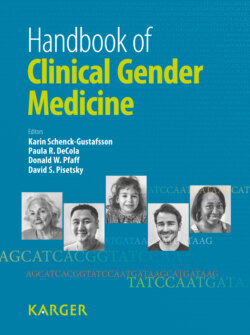Читать книгу Handbook of Clinical Gender Medicine - Группа авторов - Страница 21
На сайте Литреса книга снята с продажи.
Allocation of Resources, Empowerment, and Equity
ОглавлениеAny discussion of sex and gender requires acknowledgement of the unequal distribution of assets and power as well the existence of harmful gender norms. The differential distribution of, access to, and control over resources has an effect on health. Health is positively associated with gender equity and lack of equity has a distinctly negative impact on health [1, 17].
A key predisposing factor for an individual’s health is their level of education, which is also a driver of health literacy. Women in a number of low-and some middle-income countries, particularly in Africa and Asia, are disadvantaged due to having lower literacy rates and significantly lower rates of access to primary and/or secondary schooling in contrast to their male counterparts [11]. Moreover, it has been established that a person’s level of education is positively correlated with their use of healthcare services such as preventive services, intake of fewer prescription medicines, and a lower likelihood of inpatient hospital stays [1]. The social practice of restricting women’s attendance in school has a distinct and long-lasting influence not only on the women’s health but also on the health of their children [11]. There is a growing body of evidence that points to the importance of women’s education for child survival rates.
Although the exact numbers are not known, we know women are particularly vulnerable to poverty and in general earn less than men. Women are also subject to higher rates of unemployment, with the unemployment gap in relation to men ranging from 15% higher in countries with developed economies to 40% higher in countries with developing economies [11]. Women are also more likely than men to be in nonformal employment for which they do not receive a salary [11]. Also, in most societies men continue to hold more political power and with it have greater rein over social and economic controls. The data is very clear with regard to the socioeconomic gradient; higher levels of wealth translate into better health, and women’s financial status within most societies is less than males.
However, we have yet to gain adequate insights into how gender equity is affected within a socioeconomic level. We do not know if there is any difference between women and men in terms of their access to health or in their health outcomes within the same impoverished household.
With respect to LGBT populations, for the most part they are excluded from mainstream health policy which by nature remains largely hetero-centric. These populations are rarely considered within healthcare systems outside of the domain of HIV/ AIDS and other related diseases. Moreover, the LGBT population is largely missing from inclusion in the health disparity and diversity discussions occurring within countries such as the USA and Canada [7, 8]. The focus is limited to more ‘visible’ groups such as racial and ethnic minorities. Since LGBT populations are not readily identifiable, they are usually absent from national data sets such as health surveys, censuses, and epidemiological studies. There are either limited or inadequate measures used to identify these populations. If present they are often limited to a single question related to ‘sexual preference’ which provides minimal and possibly slanted information. Finally, the structural barriers faced by LGBT populations are significant and include the limited knowledge of health care professionals, healthcare professionals’ bias which may be largely unintended, and the lack of legal status which can prevent a partner from being able to participate in health consultations or decision making in most countries [7].
